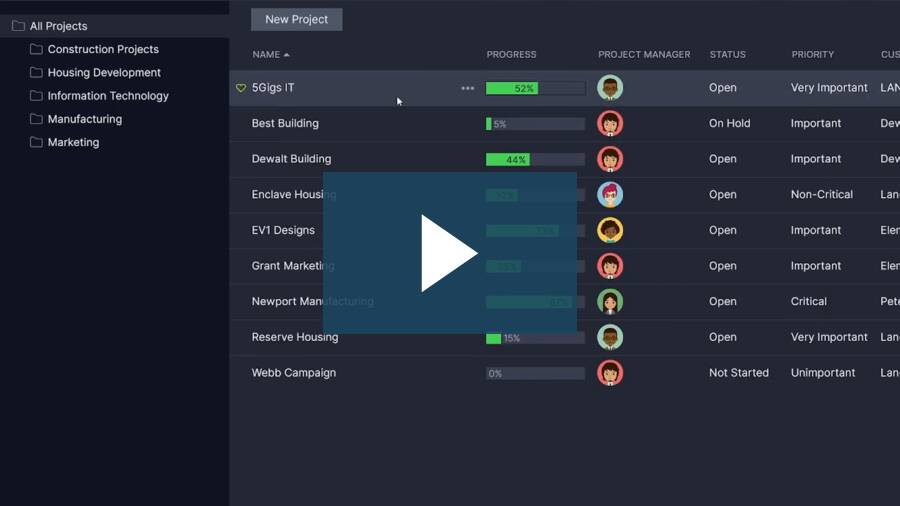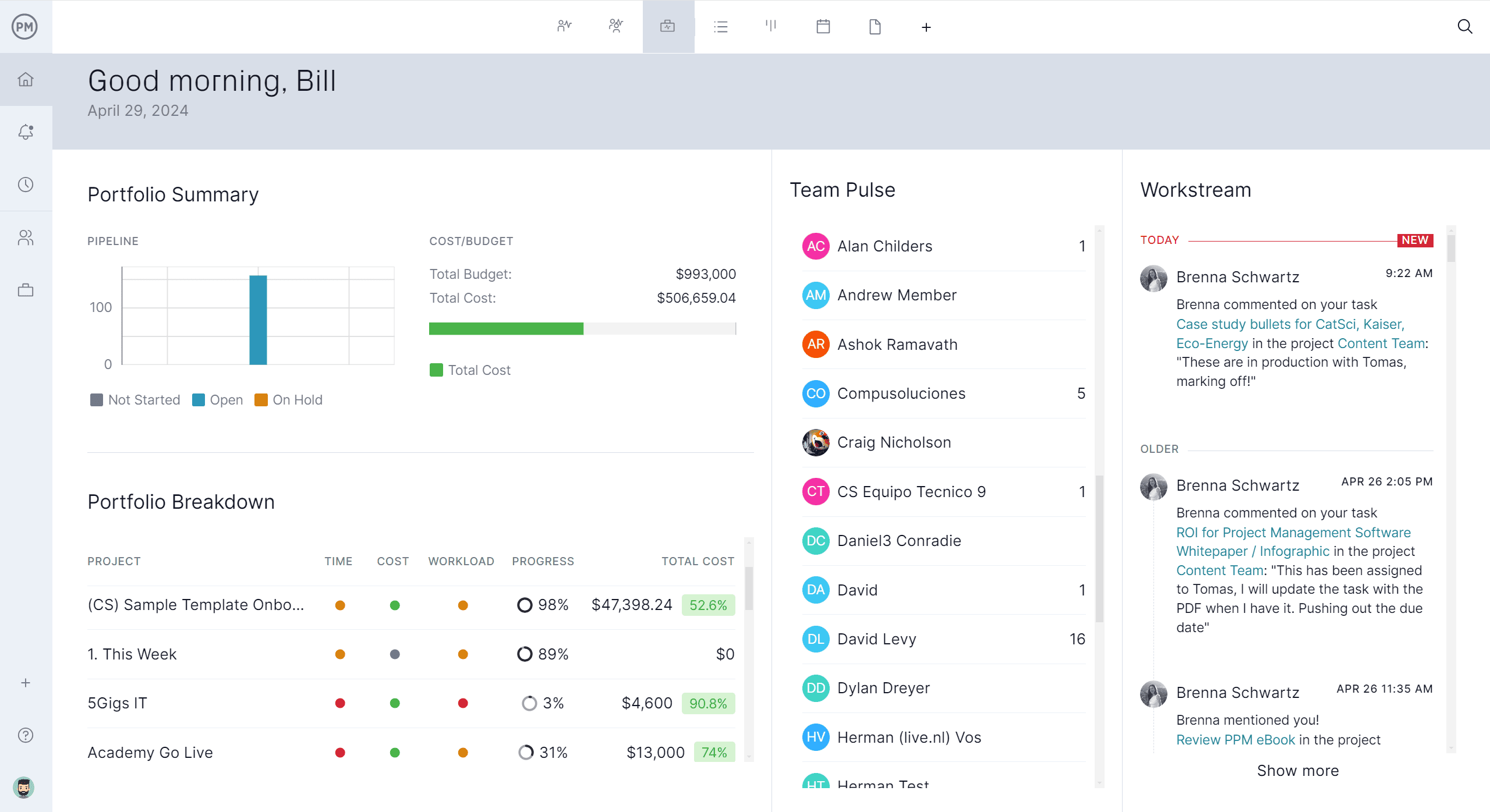Organizations today must execute multiple projects simultaneously to achieve their strategic goals efficiently. Managing these projects individually can lead to conflicts over resources and misaligned priorities. That’s where the concept of a “project portfolio” comes into play.
A project portfolio allows organizations to oversee and coordinate various projects and programs, ensuring they work in harmony toward shared objectives. In this blog, we’ll define what a project portfolio is and explain how to effectively manage one.
What Is a Project Portfolio?
A project portfolio in project management is a collection of projects and programs that are grouped to achieve strategic objectives. These projects and programs are not isolated efforts—they have synergies in terms of shared resources, aligned goals and complementary outcomes. By managing them as a portfolio, organizations can better allocate resources, reduce conflicts and ensure all initiatives contribute effectively to overarching business priorities, maximizing overall value and strategic impact.
Many types of organizations execute project portfolios, particularly in industries where multiple initiatives must align strategically. Construction firms, technology companies, healthcare providers, government agencies and manufacturing businesses commonly manage portfolios to oversee complex, interconnected projects.
These industries often face competing priorities, limited resources and tight timelines, making portfolio management essential for maintaining balance and delivering optimal results. Organizations in these sectors use portfolios to stay competitive, improve efficiency and achieve long-term business goals effectively.
A project portfolio should be managed by project management software. It provides centralized oversight, real-time data and tools that manual methods or spreadsheets can’t match. Software enables managers to track progress, budgets and resources across multiple projects simultaneously, helping them spot conflicts, prioritize effectively and align initiatives with strategic goals. It also improves collaboration by connecting teams, standardizing workflows and keeping all stakeholders informed. With features like dashboards, reports and resource planning, project management software reduces errors, increases transparency and supports better decision-making throughout the entire portfolio.
ProjectManager is award-winning project and portfolio management software that helps with project portfolio management by giving teams and leaders the tools to oversee multiple projects simultaneously with clarity and control. Our roadmap gives teams a high-level visual timeline of all projects in one place, making it easy to see how initiatives align and progress over time.
It shows start and end dates, key phases and dependencies across projects so managers can identify overlaps, prioritize work and adjust schedules when needed. This big-picture view supports strategic planning, helps allocate resources more effectively and ensures that all projects stay aligned with broader organizational goals. The roadmap keeps stakeholders informed and enables faster, more confident decisions across the entire portfolio. Get started with ProjectManager today for free.


Project Portfolio Example
Now that we’ve defined what a project portfolio is, let’s analyze what a project portfolio would look like in a real-life scenario. Imagine a construction company, Acme Construction, which manages a portfolio combining individual projects and a city redevelopment program. Individual projects include Westgate Heights, a $10M apartment complex in Chicago in phase 3; Skyview Office Tower, a $30M high-rise in phase 5; and Riverway Industrial Park, a $25M industrial site in phase 4. The diagram below shows a graphic representation of this project portfolio.
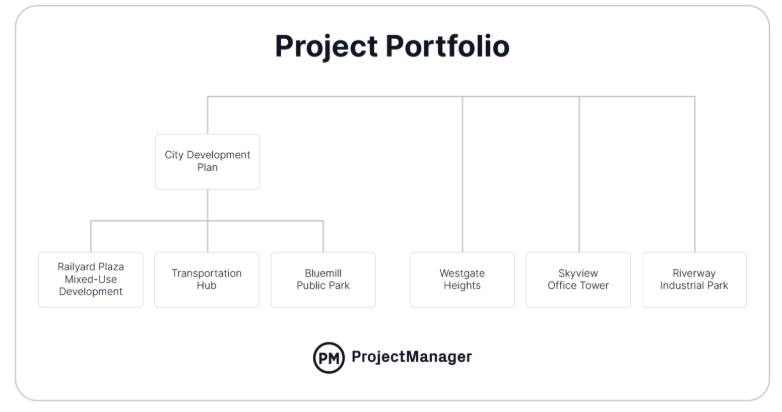

The City Redevelopment Program features Railyard Plaza, a $50M mixed-use space in design; Downtown Transportation Hub, a $25M transit project awaiting permits; and Bluemill Public Park, an $8M public space in permitting.
These projects are grouped into a program because they share the common goal of revitalizing the downtown area and enhancing its appeal. Each project complements the others by addressing different needs: Railyard Plaza provides housing and retail space, the Downtown Transportation Hub improves accessibility, and Bluemill Public Park offers recreational space. Together, they create a more vibrant, livable urban environment, attract businesses and residents, and maximize the impact of investments by aligning timelines, resources and strategic objectives.
This $148M portfolio supports economic growth, sustainability, and urban revitalization, managed by four project managers, 12 supervisors, and 300+ workers, with 85 percent of projects on track.
How to Manage a Project Portfolio
Managing a project portfolio ensures that all initiatives align with strategic priorities and use resources effectively. Below are the essential steps to plan and oversee a portfolio from scratch, making sure that projects and programs work together harmoniously to deliver maximum value and support organizational goals.
1. Define the Goals and Objectives of the Project Portfolio
The first step when planning a project portfolio is to define its goals and objectives. This involves identifying how the portfolio will contribute to the organization’s strategy, what value it should deliver and which priorities it will address. Establishing these parameters ensures all selected projects and programs align with overarching business needs and desired outcomes.
Related: Best Portfolio Management Software of 2025
2. Assign Roles for Project Portfolio Management Governance
Once the goals are set, the next step is to establish governance by assigning clear roles and responsibilities. This includes defining who will oversee the portfolio, approve projects, allocate resources and monitor progress. Effective governance ensures accountability, improves decision-making and helps coordinate efforts among stakeholders, keeping the portfolio aligned with strategic objectives and minimizing conflicts. Here’s a quick overview of the most common project portfolio governance roles and their key responsibilities.
Steering Committee
The steering committee plays a critical oversight role in project portfolio governance. It provides strategic direction, approves or rejects major decisions and ensures the portfolio aligns with organizational priorities. This group of senior stakeholders evaluates performance, addresses escalated issues and ensures resources are allocated effectively, helping maintain focus on long-term goals and minimizing risks across the portfolio.
Project Portfolio Manager
The project portfolio manager is responsible for overseeing the entire portfolio, ensuring projects and programs contribute to strategic objectives. They monitor performance, manage risks and balance resources across initiatives. Acting as a bridge between leadership and project teams, they help prioritize efforts, resolve conflicts and deliver value by keeping the portfolio aligned with organizational goals and available capacity.
Project Portfolio Management Office
The project portfolio management office (PPMO) provides structure, support and standardized processes for managing the portfolio. It collects and analyzes data, prepares reports, facilitates communication and ensures consistency in governance practices. By centralizing administration and promoting best practices, the PPMO enhances transparency, improves decision-making and supports stakeholders in aligning projects and programs with organizational strategy.
Program Manager
The program manager oversees a group of related projects within the portfolio, ensuring they deliver collective benefits and align with strategic goals. They coordinate resources, schedules and interdependencies across projects, manage risks at the program level and communicate progress to stakeholders. Their role ensures that programs contribute effectively to the portfolio’s overall value and desired business outcomes.
Project Manager
The project manager leads individual projects within the portfolio, ensuring they meet their specific objectives on time and within budget. They plan, execute and monitor project activities, manage resources and communicate progress to program or portfolio managers. By delivering successful projects, they contribute to the portfolio’s overall success and help achieve the organization’s strategic goals.
3. Establish a Project Intake Process
The project intake process in project portfolio management defines how new project ideas are submitted, evaluated and approved for inclusion in the portfolio. It ensures that only strategically aligned and feasible projects enter the pipeline. A clear intake process improves transparency, prioritization and resource allocation, helping stakeholders make informed decisions and maintain focus on organizational goals.
Project Proposal Gathering
Project proposal gathering is the first step of the intake process, where ideas and requests for new projects are collected from different departments or stakeholders. This step ensures all potential initiatives are documented, including their objectives, benefits, estimated costs and resource needs when building a project portfolio. Gathering proposals systematically helps build a comprehensive list of options for evaluation and prioritization.
Project Proposal Evaluation Criteria
The project proposal evaluation criteria define how submitted project ideas will be assessed for portfolio inclusion. These criteria often include factors like strategic alignment, expected benefits, risks, resource requirements and feasibility. Applying consistent evaluation standards ensures that decisions are objective, transparent and aligned with organizational priorities, enabling stakeholders to choose projects that deliver the greatest value.
Project Proposal Approval Process
The project proposal approval process determines how evaluated projects are formally accepted into the portfolio. This step involves presenting proposals to the steering committee or decision-makers, who review findings and make final approvals based on priorities and available resources. A clear approval process ensures accountability, timely decisions and alignment with both governance policies and strategic objectives.
4. Allocate Resources Across Projects
Optimizing resource allocation across projects is crucial for maximizing efficiency and reducing costs within a project portfolio. By strategically assigning labor, equipment and materials, organizations can minimize idle time and avoid overloading teams. Purchasing materials in bulk for multiple projects often secures lower prices and ensures timely availability.
Coordinating resource use across projects also helps prevent conflicts, improves scheduling and supports consistent progress. Effective resource allocation aligns workforce capacity with demand, balances priorities and enables smoother execution, ultimately increasing the portfolio’s overall value while conserving financial, human and physical resources throughout its lifecycle.
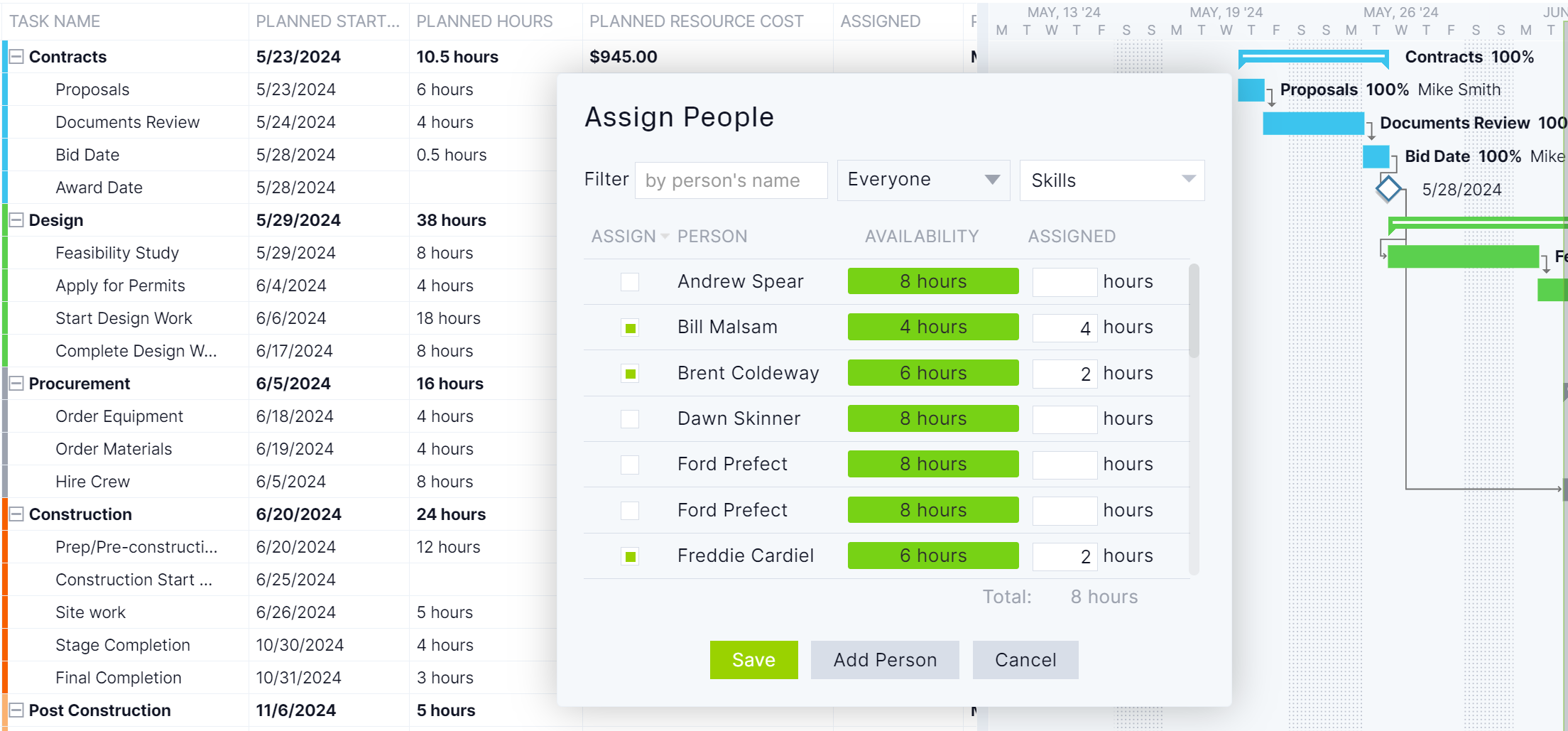

5. Monitor Project Portfolio Performance
Monitoring a project portfolio’s performance is a collaborative effort involving project managers, program managers and the portfolio manager. Together, they track progress at three levels: individual projects, programs and the overall portfolio. At each level, key project constraints such as scope, time, cost and quality are closely monitored to ensure alignment with strategic objectives and stakeholder expectations.
Project managers focus on their deliverables, while program managers oversee interrelated projects to deliver combined benefits. The portfolio manager consolidates information to assess whether the portfolio as a whole is on track. Regular reporting, dashboards and reviews help identify issues, adjust priorities and maintain alignment with goals while addressing risks and keeping resources balanced across all initiatives.


Related: 10 Free Portfolio Management Templates for Excel & Word
6. Manage Risks and Changes
Managing risks and changes is essential throughout the execution of a project portfolio. Risks and unexpected changes can affect scope, cost, timelines or quality at the project, program or portfolio level. Identifying, assessing and addressing these promptly helps minimize disruptions, ensures alignment with strategic goals and maintains stakeholder confidence while allowing the portfolio to adapt to internal or external challenges effectively.
7. Communicate with Stakeholders
Effective communication with stakeholders is critical when executing a project portfolio. Transparent, regular updates keep everyone informed about progress, risks, successes and decisions. This ensures alignment with expectations, promotes trust and facilitates timely feedback. Stakeholders can help resolve conflicts, adjust priorities and support decisions, making communication a key factor for maintaining engagement and achieving portfolio objectives collaboratively and efficiently.
8. Optimize the Project Portfolio
Optimizing a project portfolio involves continuously reviewing and adjusting its composition to ensure maximum strategic value. As circumstances, priorities and resources evolve, some projects may need to be delayed, redefined or replaced. Regular optimization helps balance risks, benefits and costs across the portfolio while improving resource utilization and aligning initiatives with changing organizational goals.
This process ensures that investments generate the highest possible returns and that the portfolio remains agile, competitive and focused on what truly matters. Optimization also identifies underperforming or misaligned projects early, freeing resources for more impactful opportunities and ensuring the portfolio stays resilient under shifting market or internal conditions.
Related Project Portfolio Management Templates
While it’s recommended that a project portfolio be managed by project management software, for those who aren’t ready to upgrade, there are other options. We offer over 100 free project management templates for Excel and Word that cover all aspects of managing projects. Here are just a few that relate specifically to portfolio management.
Project Portfolio Template
Download this free project portfolio template to organize and manage multiple projects within a single view. It includes sections for project names, objectives, status, timelines, budgets, priority levels and assigned teams. This template helps stakeholders track progress, compare performance and make informed decisions about resource allocation and strategic alignment across all active projects.
Multiple Project Tracking Template
Use this free multiple project tracking template to monitor and manage several projects at once in a single view. It includes sections for project names, start and end dates, status updates, task progress, assigned team members and key deadlines. This template helps teams stay organized, identify potential conflicts or delays and keep stakeholders informed about the performance of each project across the portfolio.
RAID Log Template
This RAID log template is a structured document used to track four critical elements across one or more projects: risks, assumptions, issues and dependencies. It includes columns for descriptions, owners, impact levels, status updates and action plans. It helps a project portfolio by providing a centralized view of potential threats and obstacles that could affect multiple projects. It supports better risk management, promotes accountability and enables proactive decision-making by allowing portfolio managers to monitor and respond to challenges before they escalate or impact strategic goals.
How ProjectManager Helps Manage a Project Portfolio
ProjectManager is better than templates for managing a project portfolio because it offers real-time data, automated tracking and centralized collaboration capabilities that static templates simply can’t match. While templates require manual updates and provide limited visibility, our software keeps all project information live and interconnected, reducing errors and improving responsiveness.
Use multiple project views to support different team needs and workflows across the portfolio. The Gantt chart gives a timeline view to track progress and dependencies, the kanban board visualizes task flow and bottlenecks, the calendar maps deadlines for better scheduling, the sheet view offers a grid layout for data sorting and the list view simplifies task tracking. These views ensure teams stay aligned while portfolio managers maintain oversight and make informed decisions across every project.
See how else our project portfolio management software can help improve outcomes and drive success.
Get Real-Time Visibility Into the Project Portfolio
Real-time portfolio dashboards and customized reports help manage a project portfolio by providing instant visibility into the status, progress and performance of all active projects in one place. The portfolio dashboard displays live data on key metrics like budget, schedule, task completion and resource allocation so managers can quickly identify risks, delays or high-priority items across the portfolio.
Customized portfolio status reports allow users to drill into specific details for individual projects or compare performance across multiple initiatives to support strategic planning and data-driven decisions. Together, these tools improve transparency, streamline oversight and help ensure all projects stay aligned with business goals.
Balance Resource Allocation Across the Portfolio
Our resource management features help manage a project portfolio by giving managers clear visibility into team capacity and workload across all active projects. Availability settings ensure that resources are scheduled based on actual working hours and time off, reducing conflicts and overbooking. The color-coded workload chart shows how tasks are distributed, making it easy to balance work and prevent burnout or delays.
The team page centralizes information on roles, assignments and capacity so managers can quickly identify who is available and adjust resources as priorities shift. These tools support efficient planning, improve productivity and help keep every project in the portfolio on track.
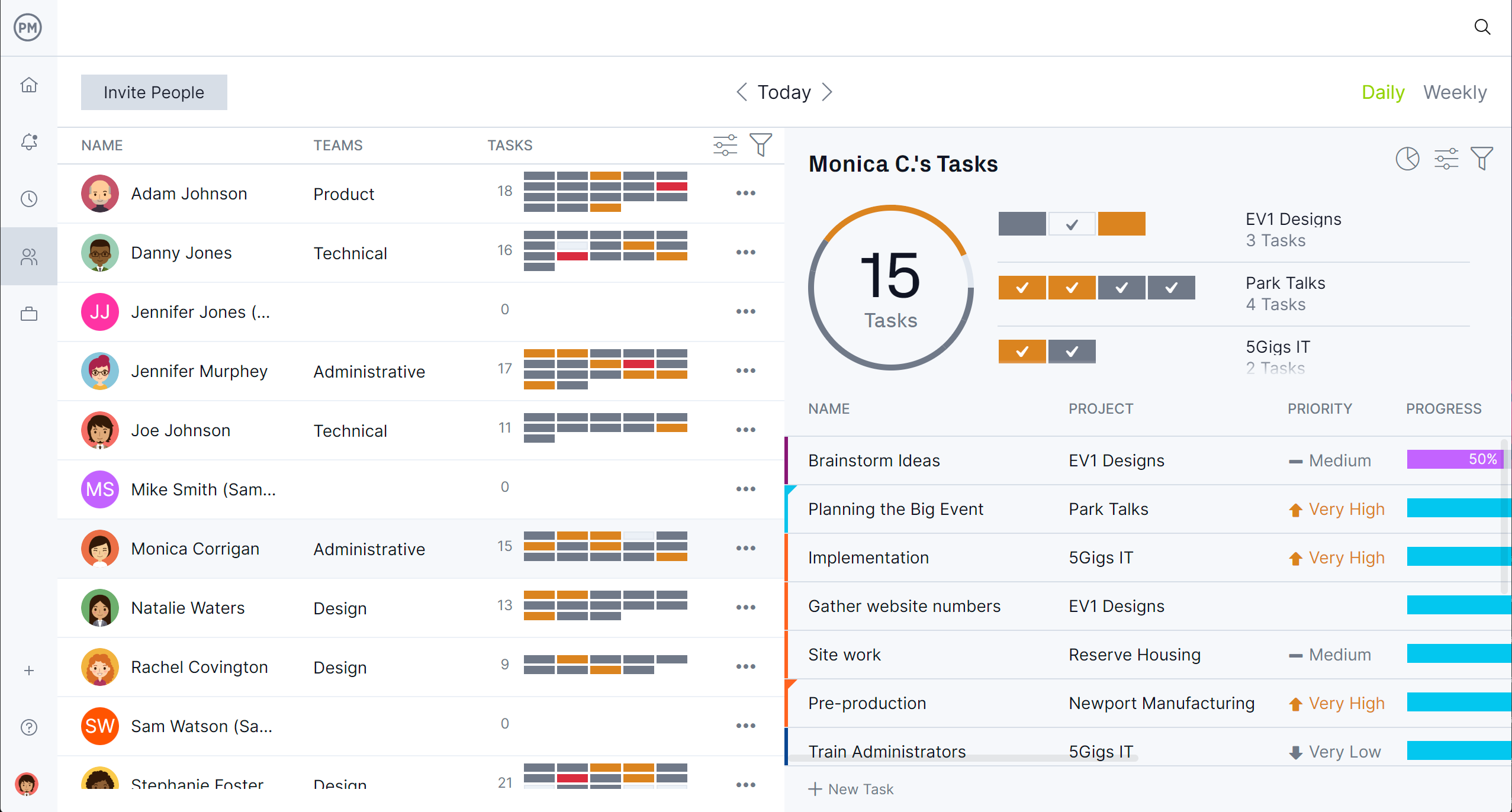

Related Project Portfolio Management Content
There’s more to a project portfolio than what we’ve covered here. For those interested in getting deeper into the topic, check out the links below. There are more free templates, a roundup of project portfolio management software and much more.
ProjectManager is online project and portfolio management software that connects teams whether they’re in the office or out in the field. They can share files, comment at the task level and stay updated with email and in-app notifications. Join teams at Avis, Nestle and Siemens who are using our software to deliver successful projects. Get started with ProjectManager today for free.




